A light gazebo provides people with protection from the scorching sun, rain and snow. However, comfortable rest is often disrupted due to a strong cold snap and gusts of wind. It is impossible to change the weather, but it is quite possible to reduce the degree of its impact. It is necessary to close the gazebo for the winter, otherwise it may be subjected to destructive effects, and the property inside will be damaged.
Optimal materials
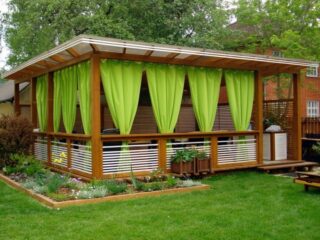
Arbors, depending on the design, can be protected from external factors in the following ways:
- open - light fabrics, nets, tulle;
- blown - dense fabrics, films, blinds;
- closed - removable or stationary structures, additional shields for protection against vandals.
The assortment and price range of building materials allow you to choose the best option for preparing the structure for winter.
Glazing
Closing the interior of the gazebo with transparent materials allows you to hide from the cold and wind, while observing the surrounding landscape in an atmosphere of maximum comfort.
There are such glazing options:
- PVC film. The blade is strong enough to withstand the toughest gusts of wind. At the same time, image distortion is minimal. Polyethylene is attached to frames, directly to the structure of the building, or is made in the form of curtains, which are fixed on special fasteners. The undoubted advantage of such a solution is the insignificant cost of its implementation.
- Plastic euro window. The products are equipped with double-glazed windows with excellent thermal insulation properties. The installation of plastic windows is expensive, but it allows you to create a comfortable microclimate inside the room, provided that heating devices are installed. Modern technologies make it possible to implement projects of any complexity. You can install windows not only in the usual rectangular shape, but also round, oval and multifaceted.
- Frameless glazing. An original and eye-catching design that perfectly protects against wind, snow and rain. There is simply no better way to create a comfortable environment in the warm season. The only downside is that such systems are made only in cold performance.
Each method has its own characteristics, pros and cons, installation and operation rules.
Curtains made of fabric or tarpaulin, bamboo
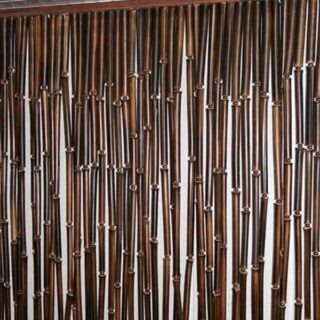
If the gazebo is used only in the warm season, there is no point in investing in expensive glazing. You can completely confine yourself to materials that are in abundance in any dacha.
You can put such things into action:
- Curtains. You need to choose dense and sturdy products that can withstand strong wind loads. To keep the edges of the canvases from tearing, they are reinforced with a border made of durable material, and in the middle they make stiffening ribs from strips of fabric folded several times.
- Tarpaulin. On the farm, it is used during construction to shelter building materials from precipitation. A well-washed tarpaulin looks good and is highly reliable. The plus is that it lets in light a little, so there won't be complete darkness in the room.
- Awning. Polymer fabrics are specially designed for extreme operating conditions and successfully withstand ultraviolet light, wind, heat and severe frost. The downside is that they do not let light through at all.We'll have to conduct electricity or make plexiglass portholes.
Each approach has the right to life, the summer resident chooses the most suitable one for his case.
Mosquito net
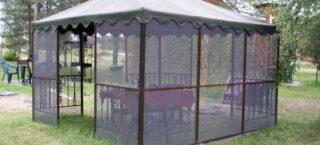
An anti-mosquito net cannot be called a universal solution against the vagaries of the weather, however, it allows, if not completely eliminating, then somewhat reducing their effect.
The undoubted advantages of this approach include:
- 100% protection against insects and birds. And this is already a lot, since mosquitoes and flies can completely ruin the process of being in nature.
- Good ventilation. Air freely penetrates in and out. Thus, the inside will always be fresh, comfortable and pleasant.
- Delay of raindrops. The mesh will get wet, but moisture will not get inside. The main thing is that a strong gust of wind does not tear the heavy fabric.
- Reducing the intensity of solar radiation. The material gives a small, but still a shadow, muffling the heat and reducing the level of ultraviolet radiation.
Depending on the design of the gazebo, open openings are closed with a net or the structure is wrapped around the perimeter. Since the wind load will only act on the clamp, it is enough to nail the net with staples. If you plan to remove it and reuse it, it is better to use plastic or wooden slats.
For work, use a coarse-mesh polymer mesh. It is not worth taking canvases made of cotton or synthetics, since they do not have sufficient strength and are difficult to clean from dirt.
Structural elements
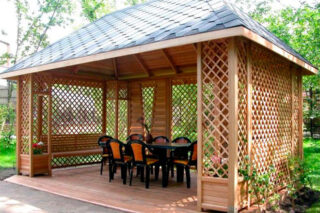
To close the windows in the gazebo, you should pay attention to the structural elements that have been successfully tested by numerous summer residents and owners of private houses.
You can isolate yourself from external factors in the following ways:
- Decorative lathing. These decor pieces are often sold with gazebos. Self-production will not take much time. It is enough to buy planed slats and knock them down into a diagonal orientation structure. With outward simplicity, the idea has many advantages. The grille partially blocks wind and precipitation, dampens sunlight.
- Sheathing with polycarbonate, clapboard or boards. This approach is considered both as a protective and in terms of conservation, when the structure is being prepared for winter. Cellular polycarbonate is a universal solution. Panels can be used to sheathe the building from all sides, leaving the inner sides transparent, and tint those that go out to the neighbors and to the street. Boards are considered rather as a temporary option, since the gazebo sheathed with them turns into an ordinary shed. In addition, having chosen the method of cladding the structure, you need to competently think over the issues of fastening the cladding.
- Landscaping with plants. Crops curling along the guides create a beautiful and pleasant to look at the outer shell of the building. The live braid prevents rain, wind and sun from entering, while providing a cozy environment and excellent air circulation. The problem is that all this happens only in the warm season. From autumn to spring, when protection is especially needed, it will be absent, as dropping the leaves, the plants will turn into thin crooked stems.
It is not necessary to dwell on any one method. If time and money are available, they can be varied, applying selectively at one time or another of the year.
Features and stages of work
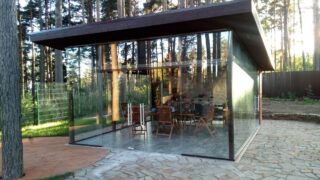
The order of the work depends on which method of closing the gazebo of the owners suits the most. In addition, the choice is determined by the material from which the supporting structures are made.
If the option with glazing is chosen, openings of the correct geometric shape with sufficient strength must be prepared for it. A 50 mm board is best suited for this. The slots remaining after the fastening are sealed with polyurethane foam and covered with platbands.Further installation is carried out in accordance with the instructions attached to the product.
For plastic panels and boards, you will need to install rails, starting, end and connecting profiles. Fastening is carried out on a seal that ensures a snug fit of the coating to the guides.
The blades do not have the same strength as the slabs and laths. The weakest points are their edges. They must be reinforced with strong bands, and the fixing points must be equipped with plastic or steel rings. To prevent the fabric from flapping in the wind, it is advisable to sew it with diagonal ribbons made of material not subject to stretching.
When landscaping a building is chosen, vertical strings are made to support the plants. The best option is a power cable that does not bend even under heavy load. The ends of the cores are twisted in holes or fastened with staples.








